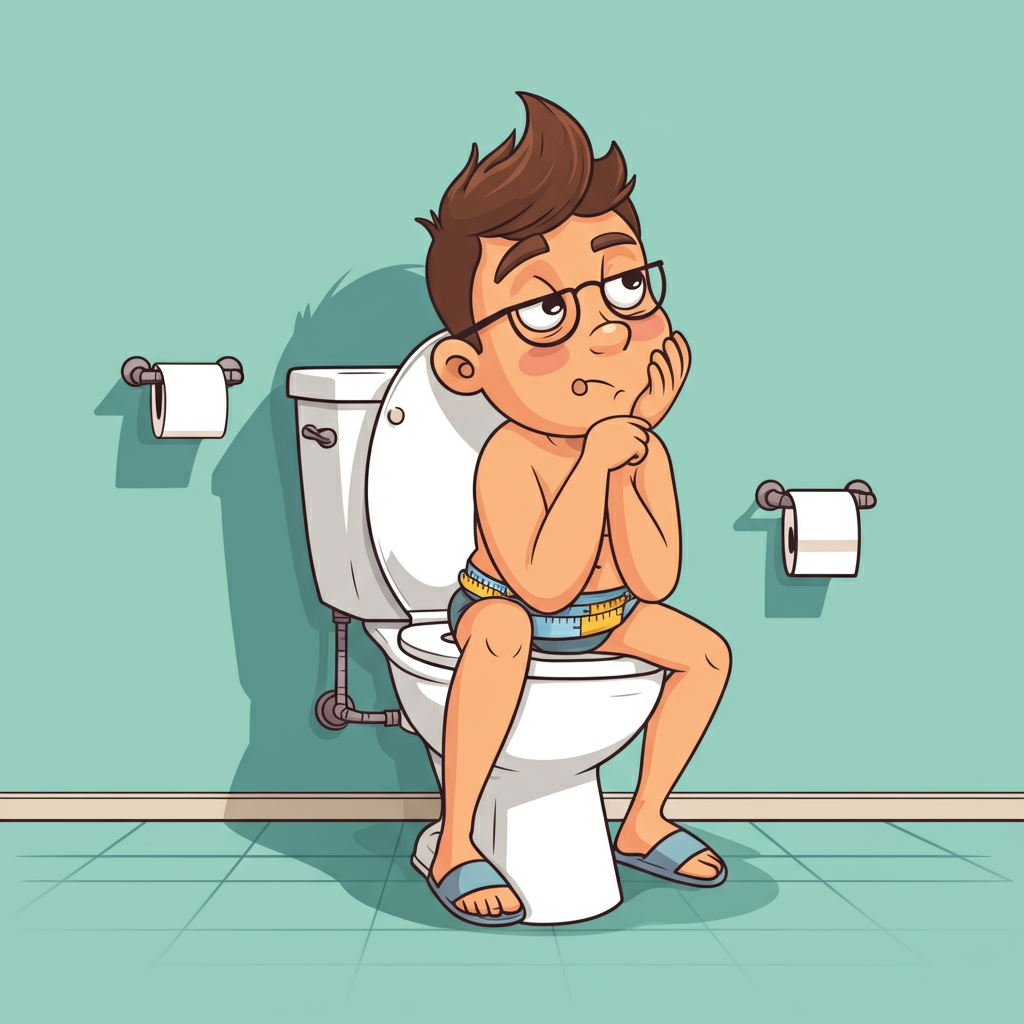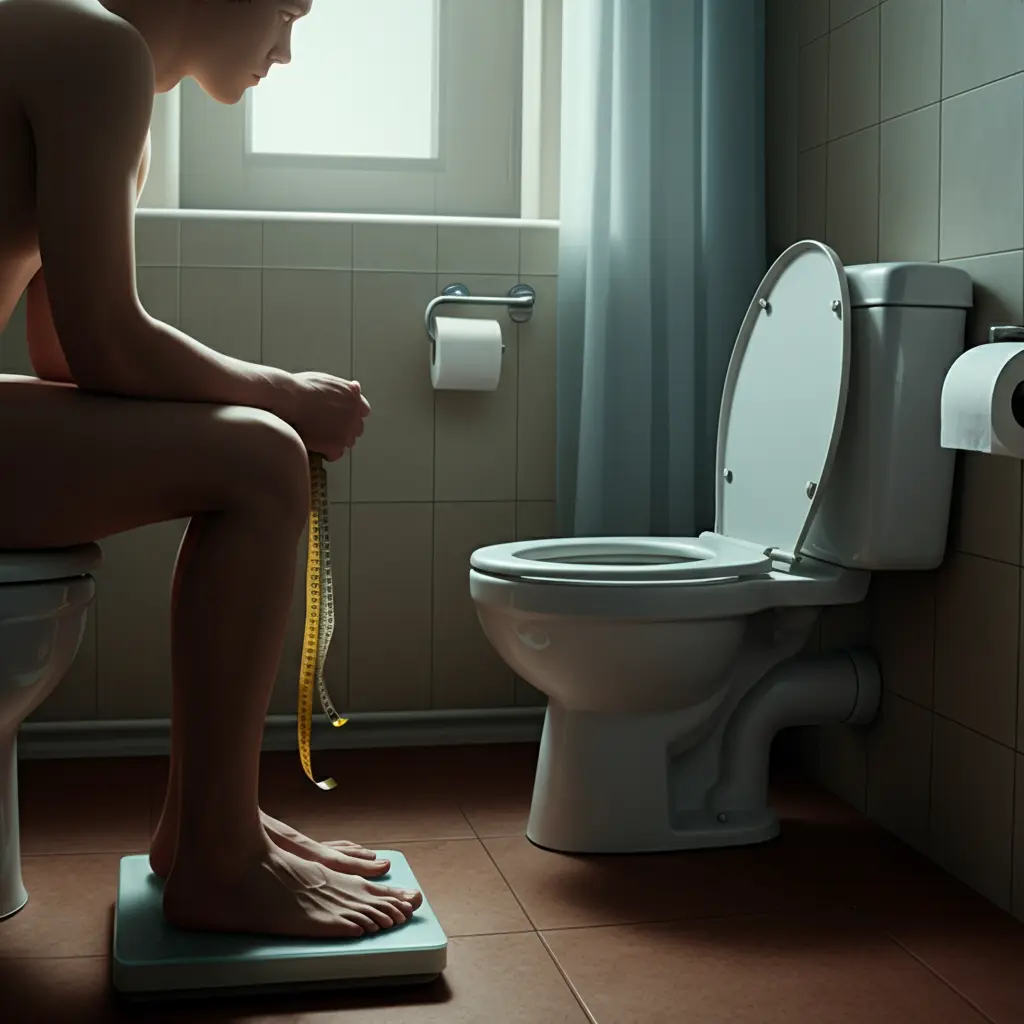When the Scale Smiles After a Bathroom Trip
You’ve done it—stepped off the toilet, hopped onto the bathroom scale, and watched the number dip lower than yesterday’s reading. For one electrifying second you think, “Awesome, I’m on my way to lose weight!” But your brain quickly chimes in: “Was that real progress or just… well, poop?”
This article is your science-backed, no-nonsense guide to what’s really happening inside your gut, why bathroom breaks shift the scale, and—most important—how to convert those fleeting drops into lasting fat loss. You’ll move from curiosity to clarity, armed with practical strategies you can use starting today.


Digestive 101: What Exactly Is Leaving Your Body?
The Composition of a Typical Bowel Movement
- Roughly 75 % water and 25 % solids—a mix of gut bacteria, undigested fiber, sloughed-off intestinal cells, and a dash of protein, fat, and minerals.
- Daily output: about 100–250 g (0.2–0.5 lb). Yes, you really can see a half-pound shift from a single visit.
- Caloric content: negligible; you’re not “burning” fat here—just discarding matter your body no longer needs.
Key takeaway: A lighter scale after pooping reflects waste removal, not a reduction in adipose tissue.
Transit Time & How It Skews Your Scale
A healthy colon moves food residue from small intestine to exit in 24–72 hours. If that journey slows (think low fiber, dehydration, stress), waste backs up, water is re-absorbed, and you feel heavier and bloated. Speed the trip too much (excess caffeine or certain medications) and you may register a rapid—yet temporary—weight dip.
A 2024 study in Gut tracked participants’ bowel habits over 48 hours and recorded up to 0.9 kg (≈2 lb) swings purely from water and stool shifts—not a gram of fat change.
Short-Term vs. Real Weight Loss: A Numbers Reality Check
- Water & Waste: The Instant Drop
- Bathroom visits flush water plus solids, so you can look and feel leaner immediately.
- Because the water portion rebounds with your next glass of H₂O, the effect is fleeting.
- Fat Mass: The Long Game
- Shedding a single pound of fat requires roughly 3,500 kcal more burned than eaten.
- Bowel movements don’t meaningfully affect your energy balance; they simply off-load non-caloric bulk.
Bottom Line
Pooping can make you lighter today, but only sustained calorie management shrinks fat cells for good.
Four Variables That Dictate “Bathroom Weight”
Fiber Intake (Your Colon’s Personal Trainer)
- Soluble fiber (oats, beans) creates a gel that slows digestion yet bulks stool.
- Insoluble fiber (wheat bran, leafy greens) speeds transit by adding texture.
- Daily target: 25 g for women, 38 g for men (Academy of Nutrition & Dietetics).
- Pro tip: Increase slowly—5 g per week—to dodge gas and cramps.
Hydration Levels
Without sufficient fluid, your colon re-absorbs extra water from stool, leaving it hard and slow-moving. Drink 2–3 L daily to keep things sliding smoothly (yes, herbal tea counts).
Gut Microbiome Balance
Friendly bacteria such as Bacteroidetes thrive on fiber, produce short-chain fatty acids, and encourage lean body composition. Fermented foods (yogurt, kimchi) plus prebiotics (onion, garlic) feed the good guys, improving regularity and potentially your waistline.
Physical Activity & Metabolic Rate
Even 30 minutes of brisk walking boosts peristalsis—the wave-like muscle contractions that push food along. Move often, and the “traffic” in your colon keeps a steady pace, which translates to less bloat and more predictable weigh-ins.
High-Fiber Recipes to Keep Things Moving
| Meal | Ingredients (per serving) | Fiber Boost (g) | Prep Tip |
|---|---|---|---|
| Apple-Oat Breakfast Jar | ½ cup rolled oats, 1 grated apple, 1 Tbsp chia seeds, 200 ml unsweetened almond milk, pinch cinnamon | 11 | Combine in a jar, chill overnight, grab-and-go |
| Rainbow Quinoa Salad | ¾ cup cooked quinoa, ¼ cup black beans, ¼ cup diced bell pepper, ½ cup baby spinach, 1 Tbsp olive oil + lemon juice | 10 | Pack dressing separately to keep veggies crisp |
| Berry-Beet Smoothie | 1 cup mixed berries, ½ cup cooked beet cubes, 1 Tbsp ground flaxseed, 1 cup cold water | 9 | Freeze berries beforehand for a milkshake texture |
| Chickpea Crunch Wrap | ½ cup mashed chickpeas, ¼ avocado, shredded lettuce, diced tomato, large whole-grain tortilla | 8 | Toast wrap lightly for a satisfying crunch |
| Lentil-Veggie Soup | 1 cup veggie broth, ½ cup cooked lentils, ¼ cup carrots, ¼ cup celery, 1 tsp cumin | 7 | Batch-cook and freeze portions for quick dinners |
Hydration Hack: Pair every extra 5 g of added fiber with 1 additional cup of water. Your colon will thank you.
Safe, Sustainable Strategies to Poop Regularly and Lose Fat
- Add fiber gradually—your gut needs time to adapt.
- Set a water timer: Sip 250 ml every hour during the workday.
- Move daily: Ten-minute walks after meals help glucose control and gut motility.
- Respect sleep: Less than seven hours disrupts hunger hormones and slows digestion.
- Manage stress: Deep breathing or meditation lowers cortisol, easing constipation and curbing emotional eating.
- Limit laxatives: Habitual stimulant laxatives can weaken colon muscles, leading to dependency.
When Bathroom Changes Signal Trouble

Red Flags Demanding Medical Advice
- Bright red or black (tarry) stool
- Persistent constipation >3 days or sudden diarrhea lasting >48 hours
- Severe abdominal pain or unexplained, rapid weight loss
- Slim, “pencil-thin” stools that could hint at obstruction
Conditions to Rule Out
- Irritable Bowel Syndrome (IBS) – alternating constipation/diarrhea, bloating.
- Inflammatory Bowel Disease (Crohn’s, Ulcerative Colitis) – chronic inflammation, blood in stool.
- Hypothyroidism – sluggish metabolism slows everything, including bowels.
- Food intolerances – lactose, gluten, or FODMAP triggers can wreak havoc on transit time.
FAQ: Your Pressing Questions About “Does Pooping Help You Lose Weight?”
- Does pooping help you lose weight permanently?
You lose waste weight, not fat. Sustainable fat loss requires a calorie deficit over time. - How many calories do you burn on the toilet?
Sitting quietly costs about 1–2 kcal/min—barely a blip on your daily expenditure. - Can frequent bowel movements speed up fat loss?
No. Frequency may lower the appearance of weight but doesn’t alter body-fat percentage. - Should you weigh yourself before or after pooping?
For consistency, weigh at the same time daily, preferably first thing in the morning after using the bathroom. - What foods make you poop and help you lose weight?
High-fiber, low-energy-density picks: leafy greens, oats, legumes, berries, chia seeds. - Is it safe to force a bowel movement to look lighter on the scale?
Forced laxative use or dehydration is risky—electrolyte imbalances, cramps, even colon damage. Stick to natural methods. - How long after eating should you expect to poop?
The gastrocolic reflex kicks in 30 minutes post-meal, but full transit from plate to toilet averages 1–3 days.
Conclusion: Flush the Myths, Embrace the Habits That Truly Help You Lose Weight
That sweet moment when the scale dips after a bathroom visit feels fantastic—but it’s not a reliable indicator of fat loss. Your body has simply released material it can’t use. To genuinely lose weight, you need a trio of practices: fiber-rich nutrition, smart hydration, and consistent movement. Layer in stress management and sleep, and you’ve built a lifestyle that keeps digestion humming and fat cells shrinking.
Call to Action: Ready for Real Results?
Download our free “Fiber & Fitness Tracker” PDF to log meals, water, and workouts for the next seven days. Compare your bathroom regularity and scale trends—then share your insights with our community in the comments below. Let’s trade constipation complaints for confident, sustainable progress—one balanced meal, one brisk walk, and yes, one satisfying bathroom break at a time.


